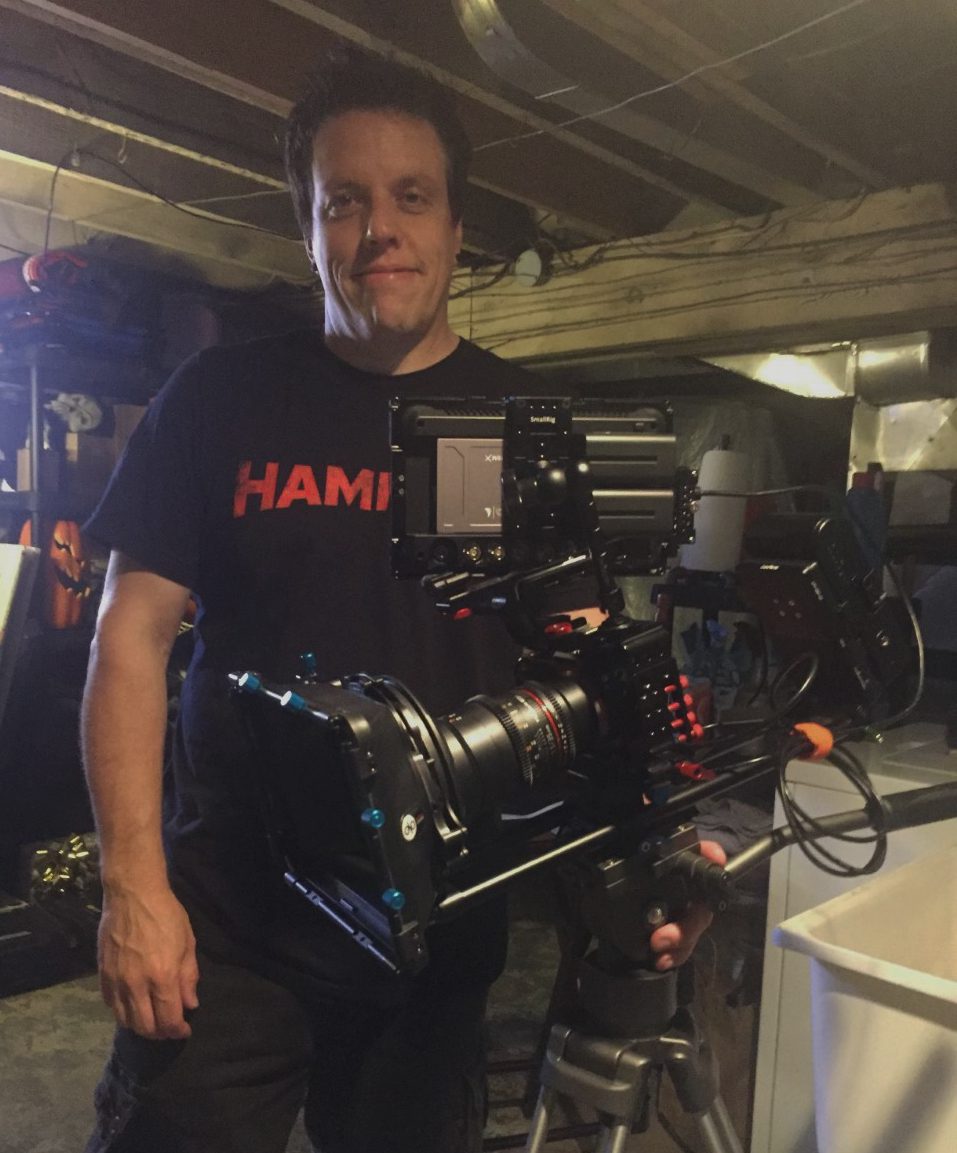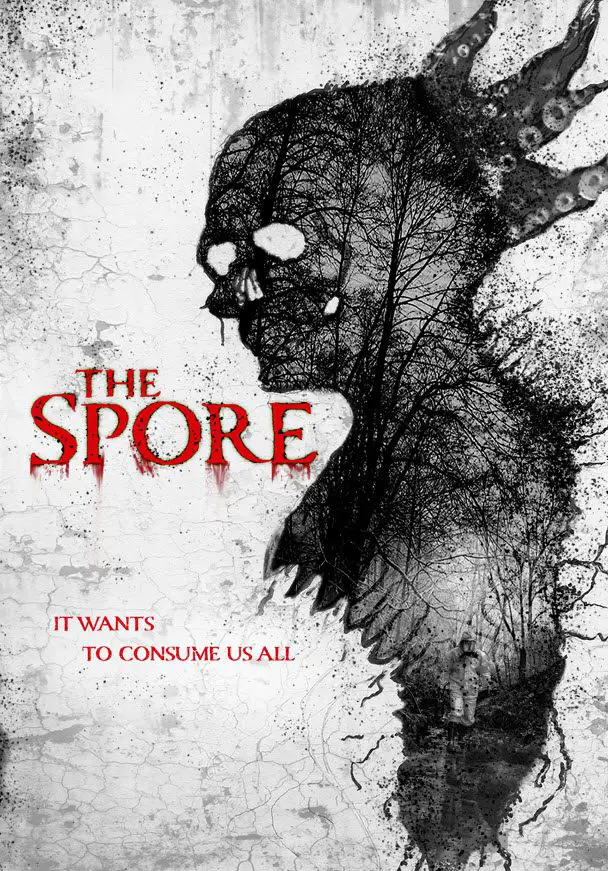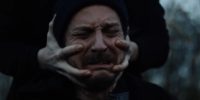The Spore blew my mind: it’s one of those films that seems fairly humble at first but brings in shocks and surprises at every other turn. This is not to say it is an action-packed film; this is, after all, about the spread of—yes—a spore. Nevertheless, I’m kicking myself that I cannot be there in person at Grimmfest’s screening in a couple of weeks.
Talking to its writer and director, Matt Cunningham, more than made up for that. I asked him how it feels now that the world premiere is imminent. “It’s amazing,” said Matt, though a little hesitant. “This will be my first premiere at a festival. Part of the sad thing is with everything going on and travel being restricted…I want to be there so bad, but with passport issues and COVID, I can’t be in the theatre to experience it. It’s a little heartbreaking, but I’m glad that people will get to see it, and it’s in a theatre, where it should be.”
Not just in the theatre. I was able to tell Matt that The Spore will feature in Grimmfest’s virtual edition the following week, so the whole country can watch it, not just those in one venue.
I discovered with my next question that IMDb had caught me out in my homework: the listing for “D.M. Cunningham” does not give the full picture. I had the impression that this was Matt’s first feature film as a director, after a number of shorts, but he corrected that misunderstanding. “No. Here’s the fun little background. I’ve been working in the film and television business for about twenty-two years. The first big movie I ever worked on was Starship Troopers. I was Phil Tippett’s visual effects assistant on that movie on set. During that time, I had shot my first movie that I ever did, and that was released through Troma when I was really young. I originally came from Colorado, and then I moved to Los Angeles when I was young and spent half my life there. So I was working in the film business, working on TV shows, sold stuff to Disney, wrote on TV shows, all sorts of stuff.
“I had a column in a magazine called Famous Monsters of Filmland, and as I started writing for that magazine, I got to know some of my heroes, like Robert Englund and Wes Craven. He was one of my big influences. Eventually, Wes and I hit it off and became friends. We would go to breakfast and stuff, and at one point he said to me, ‘You got into this business to make horror films,’ which is what I got into it for. I started in make-up effects, doing those kinds of things, but I just wanted to make horror films. I got a little side-tracked, as you do, in the business. You start working on shows, you make money, it feels good; but like he said, you’ve got to get back to doing the thing that you love at some point. So I kind of rebooted myself at that point. I was writing books, and I’d just released a young adult novel under ‘D.M.’ My full name is David Matthew Cunningham, but my book publisher had said, ‘You should go by D.M., that goes really well for books.’ When I rebooted, that name had stuck, and I started with making short films. So I do have a long history of these things, but that’s why the career comes in two parts.”
So I had to kind of reboot my approach to these questions, holding back my urge to ask for anecdotes. I focused my attention instead on The Spore, possibly one of the most pessimistic of stories, and I asked Matt what his inspirations were. “Believe it or not, George Romero was a key influence. I was thinking about Night of the Living Dead. Something is happening to a community; no one knows what or why it is. Then I think I was listening to something on the radio, and they were talking about the ice caps melting and suggesting that no one knows what’s in that melting ice! There could be spores or something hidden in this ice, and it could get out there, and who knows what would happen! That was what started it.
“We shot the film before we knew anything about coronavirus, and I’m writing these things because all this stuff is downloading into my brain. We make this movie, and we wrap just a week before everything shuts down. And then I start hearing things in the news that I had put into the script, almost verbatim! What is going on here? It was really weird, and everyone was like, ‘I don’t know what you’re going to write next, but be careful.’ I wanted to do a movie where something is happening in the community and everyone is just trying to get a handle on things, and we’re all just back here watching it. I wanted to do it segmented, so it just touches people’s lives, like it was doing with COVID at times. You don’t know what’s really happening, it’s just this crazy thing that’s going on and touching everybody in some form or fashion. And I wanted to do something with cool creature effects because that’s what I’ve grown up on. I love physical effects, I worked in the effects shop for a while too.”

As he had alluded to the episodic structure of the film (which somewhat reminded me of Max Books’ novel World War Z), I asked how that came about. “I had read that book,” he said, “quite a while ago, and yes it probably stuck in there. But really it came down to production: how can we shoot the movie? I’ve got to go over here and shoot this segment, and I want to create this, and then intertwine it into this segment…I didn’t want to necessarily have just one person to track for the entire story because it was a unique approach to a horror story where we’re just showing different people and a community and how it all connected in a way, but people were still just strangers to each other. I had to make that work, especially at the end when they’re having a conversation in a garage about who they all are and how they came together. That’s the telling of the story that I wanted, and I wanted it to be a little different—new and yet old—as a story.”
It’s almost like we’re watching a journal of this outbreak—not from the beginning but perhaps bang in the middle, watching it progress from a small-scale perspective.
As for the story, I asked Matt whether it came with a message; “we’re all doomed” felt about right to me! “Well, I’m actually a very optimistic person,” Matt laughed. “Really I wanted to tell an ecological horror story. I’m quite terrified thinking about those kinds of things because I have children, and I can’t help wondering what the world is going to be like in twenty or fifty years’ time. I’m not sure if there’s a message here, but if there is, it’s about the things we’re doing to the world. We’re kind of creating monsters from everything we’re doing. Spore clouds have been around since way before us, and they’re going to be here after us. We’re just a blip in that story, you know? For me, I wanted to create an eco-horror because I’ve not seen anything like that since The Thing, when something came out of the ice. Think about what that did to a human body. I’m a big fan of The Thing and of course, Rob Bottin and all of his effects work.”
That brought us neatly on to the effects. I really wanted to ask something but had struggled to find words beyond “wow.” I asked Matt how he devised what the mutations would look like. “Well, my producing partner Brian Hillard and I both came from effects shops. He had worked on The Walking Dead, I’d worked on The Predator, between us some big effects titles. So we talked about cool things that we hadn’t seen much of and what would be fun to do. We built everything in our own effects shop (which is essentially my basement), we set everything aside and just built a bunch of these…things! We had done some research on these microscopic worm things (I forget what they’re called) and all these weird worms full of teeth caught on us: ‘Wouldn’t it be cool if this is the kind of thing that grew out of people?’ And they started turning into these things. They got infected, they’d lose their minds a little bit and then start to change. But I didn’t want to do a full transformation, kind of just wanted the audience to ask themselves, ‘Is that what happened?’ to be like putting it together.”
I had found it surprising. Even from the brief write-up on the Grimmfest page, it was impossible to tell what to expect; so when the effects appeared in front of me on the screen, it was a big surprise, especially as things escalated. I thanked Matt for such an effective film, which actually came with another surprise: there was such a lot of body horror but no violence as such, and I suggested I might show the film to my fourteen-year-old. “My daughter is in the movie, actually,” Matt said. (He told me which part she plays, but I’m not going to share for the sake of avoiding spoilers.) “She doesn’t want to watch the film but loves being in these things. We had such fun with these effects, the body horror was very Cronenberg—I love Cronenberg and when he does body horror—I guess I just wanted to have a monster taking over. Going back to horror films that I’d loved, like The Blob from 1988, which is one of my favourite movies: I loved the effects in that, watching it take over people. That was fun, and I wanted to do something fun and weird.”
Matt having mentioned his daughter reminded me that many in the cast were new to acting. I asked whether that was a challenge, or like working with clean slates. “They were all incredibly good, they all took direction very well,” said Matt. “It was a challenge and a risk to do that, going with unknowns, but I also felt to some degree that it would add to the movie. These are not polished actors, and so this could feel a little bit more real.” That made sense to me: a gritty film rather than glam was clearly the aim.
“Absolutely. We were going for small town, we should make it feel like these were real people from that town, and we’re just dropping into their place, seeing it with them. And you don’t see a face, someone well known, because that might stop you, and pull you out.”

Considering The Spore was, as he had said, set in one small town, I asked whether there were plans to show what happens elsewhere or in the big picture. “In the background, don’t forget, there’s news reports playing on the radio,” Matt reminded me. “That was influenced by Orson Welles’ War of the Worlds broadcast. I’ve always loved that, and I wanted a feeder like that in the background. But I absolutely do have an idea for a follow-up, and it would probably go more like Invasion of the Bodysnatchers. I was already thinking about where the film could go when I was writing it, I’d love to do one in that space, with strange things that happen.”
Matt was also behind the music in The Spore, under the name of Dreaming In Neon. “Yeah, that came from the influence of John Carpenter, Tangerine Dream, stuff like that. My bandmate Chad Cherry and I (he lives in Los Angeles) kind of create a score and send it back and forth to each other. So we’ve been doing that for the new feature that we’re just finishing post on, too. We both just kind of been synth nerds, made a connection, and made the music.”
So after talk of follow-ups and a new feature, I wanted to know more. What’s next for Matt? “I’m actually finishing this week all the editing on a movie that we shot in the pandemic, called 3 Demons, which is kind of like a Lynchian possession movie. So it’s a mind-f**k of a movie where you can’t tell what’s going on, and the response so far has been visceral, for sure.”
And is The Spore going to spread around the world? “Yeah, it releases in the States on November 9 through Lionsgate.”
The world premiere of The Spore takes place on 9 October at Grimmfest in Manchester, and if you are unable to get there, it can also be viewed from home in the Grimmfest virtual edition on 15 October (in a double bill with The Pizzagate Massacre).


